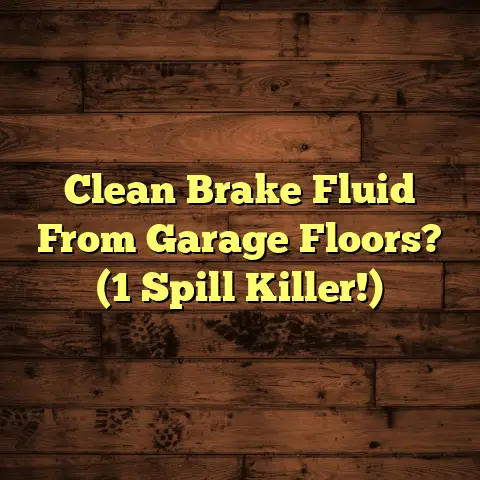Steam Cleaning Laminate Floors: Good Idea? (2 Big Risks!)
I get it. You want a sparkling clean home, and the allure of a steam cleaner zipping across your laminate floors, promising a sanitized, gleaming surface is strong.
Especially here in the PNW, where the rain seems to track mud and grime indoors year-round. Steam cleaning is marketed as a quick, easy solution.
But is it really the best option for your laminate?
Laminate flooring is fantastic. It’s affordable, looks great, and is generally easy to maintain.
But I’m here to tell you that steam cleaning laminate floors can be a risky game.
I’ve seen firsthand the damage it can cause.
In this article, I’m diving deep into the potential pitfalls of steam cleaning your laminate.
I’ll expose two major risks that could cost you time, money, and a whole lot of frustration.
So, grab a coffee (or a craft beer – PNW style!), and let’s get into it.
Understanding Laminate Flooring
First, let’s level-set on what laminate flooring actually is.
It’s not hardwood. It’s a multi-layer synthetic flooring product fused together through a lamination process.
Typically, you’ve got a high-density fiberboard (HDF) core, a decorative photographic layer that gives it the wood (or stone, or tile) look, and a protective wear layer on top.
Why is laminate so popular here in Washington and Oregon?
Well, for starters, it’s budget-friendly.
According to a 2023 report by Statista, laminate flooring is consistently one of the most affordable hard flooring options available, making it attractive to homeowners and renters alike.
Plus, it’s durable enough to handle the wear and tear of kids, pets, and our active PNW lifestyles.
I’ve installed laminate in countless homes, apartments, and even light commercial spaces throughout the region.
It’s versatile and can mimic the look of more expensive materials without the hefty price tag.
Generally, laminate floors are pretty low-maintenance.
A quick sweep or vacuum followed by a damp mop is usually all you need to keep them looking their best.
But that “damp mop” part is crucial. We’ll get to why in a bit.
The Rise of Steam Cleaning
Now, let’s talk steam cleaners. These machines use hot steam to loosen dirt and grime, promising a deep clean without the need for harsh chemicals.
Sounds amazing, right?
The appeal is obvious.
Who wouldn’t want a quick and easy way to sanitize their floors, especially when you’re juggling work, family, and trying to squeeze in a hike in the Cascades?
In the Pacific Northwest, I’ve noticed a surge in steam cleaner popularity.
Maybe it’s because we’re all trying to combat the constant dampness and the dirt it brings.
I’ve heard homeowners rave about how steam cleaning supposedly kills allergens, bacteria, and gets rid of stubborn stains.
But here’s the thing:
While steam cleaning can be effective on certain surfaces, it’s often misunderstood, especially when it comes to laminate.
The intense heat and moisture can actually do more harm than good.
Risk 1 – Moisture Damage
Okay, let’s get to the heart of the matter.
The biggest risk of steam cleaning laminate flooring is moisture damage.
Remember that HDF core I mentioned earlier?
Well, it’s essentially compressed wood fibers.
And wood, as you know, loves to absorb moisture.
When you steam clean, you’re forcing hot, humid air into the seams and edges of the laminate planks.
This moisture can then seep into the HDF core, causing it to swell, warp, and even delaminate.
I’ve seen it happen countless times.
Homeowners call me in a panic, showing me floors that are buckling, bubbling, or have visible signs of water damage.
And guess what?
Nine times out of ten, the culprit is steam cleaning.
Let me share a specific example.
I recently worked with a homeowner in Seattle who had steam cleaned her laminate floors weekly for a year.
She thought she was doing a great job keeping things clean and sanitized.
But over time, the edges of the planks started to swell, and the decorative layer began to peel away.
The floor looked awful, and she had to replace the entire thing.
The cost? Thousands of dollars.
Now, you might be thinking, “Well, I’ll just be careful and use a low steam setting.”
But even a small amount of moisture can be problematic.
Laminate is simply not designed to withstand the prolonged exposure to heat and humidity that steam cleaning provides.
Compared to other flooring types like tile or solid hardwood, laminate is particularly vulnerable.
Tile is impervious to water, and solid hardwood can be refinished if it gets damaged.
But once laminate is water damaged, there’s often no turning back.
Here’s what a local flooring expert, Sarah Miller from “NW Floors & Interiors” in Portland, told me:
“In the Pacific Northwest, with our naturally high humidity levels, steam cleaning laminate is like playing Russian roulette. It might seem fine at first, but eventually, the moisture will find its way in and cause irreversible damage.”
Risk 2 – Warranty Voids
The second major risk of steam cleaning laminate floors is that it can void your manufacturer’s warranty.
Most laminate flooring warranties have specific clauses that outline what types of cleaning methods are acceptable.
And guess what?
Steam cleaning is almost always on the “do not use” list.
Why?
Because manufacturers know that steam cleaning can damage their product.
Warranties typically cover manufacturing defects, like faulty seams or premature wear.
But they don’t cover damage caused by improper maintenance, including steam cleaning.
I’ve seen homeowners get stuck with hefty repair or replacement bills because they voided their warranty by steam cleaning.
Let me give you another real-life example.
I had a client in Vancouver, WA, who had installed a beautiful new laminate floor throughout her home.
She decided to steam clean it to get rid of some pet stains.
A few months later, the floor started to buckle in several areas.
She contacted the manufacturer to file a warranty claim, but it was denied because she had used a steam cleaner.
She was out of luck and had to pay for the repairs herself.
I looked into some popular laminate brands in our area, like Pergo and Armstrong.
Their warranty guidelines explicitly state that steam cleaning is not recommended and can void the warranty.
It’s crucial to read your warranty carefully before you start cleaning your floors.
Don’t assume that because a cleaning method is popular, it’s safe for your laminate.
Here’s a testimonial from a homeowner in Eugene, Oregon, who learned this lesson the hard way:
“I wish I had known about the warranty issue before I steam cleaned my floors. Now I’m stuck with damaged floors and no recourse. It’s a costly mistake I won’t make again.”
Alternative Cleaning Methods
Okay, so steam cleaning is a no-go.
But how do you keep your laminate floors clean and looking their best without risking damage or voiding your warranty?
The good news is there are plenty of safe and effective alternatives.
1. Dry Mopping:
This is your first line of defense.
Use a microfiber dust mop to regularly remove dust, dirt, and pet hair.
This will prevent grime from building up and scratching the surface of your floor.
2. Damp Mopping:
For a deeper clean, use a damp mop with a laminate-specific cleaner.
Make sure your mop is only slightly damp, not soaking wet.
You want to avoid getting excess water on the floor.
I recommend using a spray bottle to apply the cleaner directly to the mop head, rather than spraying it on the floor.
3. Laminate Floor Cleaners:
There are many excellent laminate floor cleaners available on the market.
Look for pH-neutral cleaners specifically designed for laminate.
Avoid using harsh chemicals, abrasive cleaners, or oil-based soaps, as these can damage the finish.
4. Spot Cleaning:
For spills and stains, clean them up immediately with a soft cloth and a laminate-safe cleaner.
Avoid letting spills sit for extended periods, as they can seep into the seams and cause damage.
5. Preventative Care:
Prevention is key.
Use doormats at entrances to trap dirt and moisture.
Place furniture pads under the legs of chairs and tables to prevent scratches.
And avoid wearing shoes with sharp heels or cleats on your laminate floors.
Here’s a tip from another local flooring expert, David Chen from “Evergreen Flooring Solutions” in Seattle:
“In the Pacific Northwest, where we have higher humidity, it’s especially important to maintain good ventilation in your home. This will help prevent moisture buildup and protect your laminate floors.”
Conclusion
So, is steam cleaning laminate floors a good idea?
Based on my experience and the insights of other flooring professionals, the answer is a resounding no.
The risks of moisture damage and warranty voids are simply too great.
While the allure of a quick and easy cleaning solution is understandable, it’s not worth jeopardizing the integrity and longevity of your laminate floors.
I encourage you to make an informed decision about your cleaning methods.
Consider the potential consequences of steam cleaning and weigh them against the benefits.
Remember, a little caution and preventative care can go a long way in protecting your investment and keeping your laminate floors looking beautiful for years to come.
In the Pacific Northwest, we value both convenience and care.
Let’s strike the right balance and prioritize the long-term health of our homes over a fleeting sense of cleanliness.





